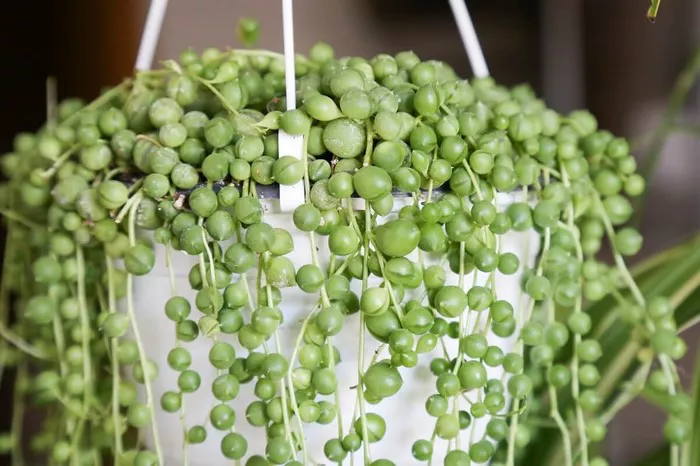Succulents have surged in popularity over recent years, adorning homes, offices, and outdoor spaces with their unique beauty and low maintenance requirements. Among the diverse array of succulents available, pearl succulents stand out for their striking appearance and distinctively shaped leaves. Belonging to the genus Senecio, these plants, also known as Senecio rowleyanus, feature round, bead-like leaves that resemble strings of pearls, hence their common name. While they may appear delicate, with proper care, pearl succulents can thrive and become an eye-catching addition to any plant collection. In this guide, we will delve into the essential aspects of caring for pearl succulents to ensure their health and longevity.
Understanding Pearl Succulents:
Before delving into care instructions, it’s crucial to understand the natural habitat and characteristics of pearl succulents. Native to arid regions of South Africa, these plants have adapted to thrive in conditions with plenty of sunlight and minimal water. Their unique leaves serve as reservoirs for storing water, allowing them to withstand periods of drought. Understanding their natural habitat provides valuable insights into replicating optimal growing conditions in a home environment.
Light Requirements:
Proper lighting is essential for the health and growth of pearl succulents. These plants thrive in bright, indirect sunlight. Placing them near a south or west-facing window where they can receive several hours of sunlight per day is ideal. However, it’s essential to avoid exposing them to direct sunlight for extended periods, as this can lead to sunburn and damage the delicate leaves. If natural light is insufficient, supplement with artificial grow lights designed for succulents to ensure they receive the necessary light intensity.
Watering:
One of the most common mistakes in succulent care is overwatering, and pearl succulents are no exception. These plants are highly susceptible to root rot if their soil remains consistently moist. The key to watering pearl succulents effectively is to allow the soil to dry out completely between waterings. Stick to a watering schedule of once every two to three weeks during the growing season (spring and summer) and reduce frequency to once a month during the dormant period (fall and winter). When watering, thoroughly saturate the soil until water drains from the bottom of the pot, ensuring that excess moisture doesn’t accumulate around the roots.
Soil and Potting:
Choosing the right soil mix and potting container is crucial for promoting healthy growth in pearl succulents. Opt for a well-draining potting mix specifically formulated for succulents and cacti. A mix containing perlite, coarse sand, or pumice will ensure adequate drainage and prevent waterlogged soil. When repotting, select a container with drainage holes to allow excess water to escape freely. Additionally, choose a pot that provides ample room for the succulent’s root system to grow, but avoid oversized containers as they can retain excess moisture.
Temperature and Humidity:
Pearl succulents thrive in warm, dry climates and prefer temperatures between 65°F to 80°F (18°C to 27°C). While they can tolerate slightly cooler temperatures, it’s essential to protect them from frost and extreme cold, as prolonged exposure can damage their delicate foliage. Maintain moderate humidity levels around the plant, as excessively dry air can lead to dehydration, while high humidity can encourage fungal diseases. Adequate air circulation is also crucial for preventing moisture buildup and maintaining plant health.
Fertilization:
Unlike some other plants, pearl succulents do not require frequent fertilization. During the growing season in spring and summer, you can supplement their nutrient intake with a balanced, water-soluble fertilizer diluted to half strength. Apply fertilizer sparingly, approximately once a month, to avoid overfeeding, which can cause fertilizer burn or excessive growth. Refrain from fertilizing during the dormant period in fall and winter, as the plant’s growth slows, and it requires fewer nutrients.
Pruning and Maintenance:
Regular pruning helps maintain the compact, trailing growth habit of pearl succulents and promotes overall plant health. Remove any dead or yellowing leaves by gently pinching them off at the base using clean pruning shears. This not only enhances the plant’s appearance but also prevents the spread of disease and conserves its energy for new growth. Additionally, periodically check for signs of pests such as mealybugs or aphids, especially in the crevices between the succulent’s bead-like leaves. If detected, promptly treat the infestation with an organic insecticidal soap or neem oil spray.
Propagation:
One of the joys of growing pearl succulents is the opportunity to propagate new plants from existing ones. These succulents are easily propagated through stem cuttings, which can be taken during the spring or summer months when the plant is actively growing. Simply snip a healthy stem measuring a few inches in length and remove any lower leaves to expose the nodes. Allow the cutting to callus over for a few days, then plant it in a well-draining succulent mix and keep the soil lightly moist until roots develop. With proper care, the cutting will establish roots and grow into a new pearl succulent plant.
Conclusion
Caring for pearl succulents requires a combination of attention to detail and understanding of their unique needs. By providing adequate light, water, and well-draining soil, you can ensure that these charming plants thrive and grace your space with their beauty. Remember to monitor their growth regularly, adjust care routines as needed, and enjoy the rewarding experience of cultivating healthy pearl succulents. With the knowledge gained from this guide, you’ll be well-equipped to nurture these captivating plants and showcase them as stunning additions to your indoor or outdoor garden.


